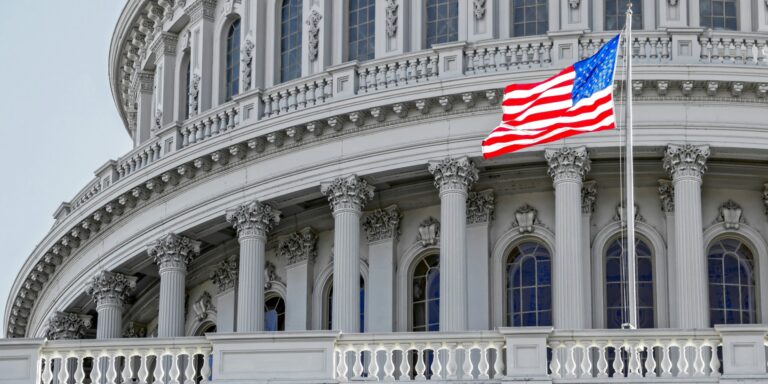In a closely contested decision on May 22, 2025, the U.S. House of Representatives passed the “One Big Beautiful Bill” with a razor-thin 215–214 vote. This sprawling legislation, a cornerstone of President Donald Trump’s second-term policy agenda, introduces sweeping changes to tax policy, government spending, and regulatory measures. The bill’s narrow passage underscores the deep partisan divide in Congress and sets the stage for an equally intense battle in the Senate.
Broad-Spectrum Legislation
The bill, commonly referred to as H.R. 1, serves as a comprehensive budget reconciliation measure. At over 1,000 pages long, it outlines substantial shifts in U.S. fiscal and social policy. Among the most discussed elements are:
- Tax Reforms: Continuation of the 2017 tax cuts, new exemptions for overtime and tip income, and a dramatic increase in the state and local tax (SALT) deduction cap for middle-income earners.
- Spending Cuts: Reduction in federal spending on social programs including Medicaid and the Supplemental Nutrition Assistance Program (SNAP). New work requirements and eligibility guidelines are also introduced.
- Defense and Security: Increased allocations for military expenditures and border enforcement infrastructure.
- Energy and Environment: Rollbacks on clean energy subsidies and tax credits established in prior legislation.
- Healthcare Policies: Tightened restrictions on federal healthcare funding, including a nationwide ban on Medicaid coverage for gender-affirming procedures and a halt on funding for clinics providing abortion services.
These policy changes reflect a dramatic shift in the federal government’s approach to taxation, welfare, and healthcare, signaling a rollback of several key reforms implemented in previous administrations.
Fiscal Projections and Deficit Concerns
Despite introducing several cost-cutting measures, the bill is projected to increase the federal deficit by approximately $2.6 trillion over the next ten years. This spike is largely attributed to extended tax breaks and expanded defense funding. The deficit projections have raised alarms among financial analysts and credit agencies, some of which have adjusted the country’s credit outlook in anticipation of heightened fiscal pressure.
Critics argue that while the bill does contain spending reductions, the scale of tax cuts outpaces the savings, undermining its fiscal prudence. Proponents, on the other hand, argue that the bill will stimulate economic growth, increase investment, and strengthen national security.
Political Landscape and Divisions
The passage of the bill highlights deep fissures within both political parties. On the Republican side, while leadership hailed the bill as a legislative triumph, a handful of GOP members broke ranks. Representatives voiced concerns over the ballooning deficit and the bill’s lack of deeper spending reforms. Notably, one Republican member voted “present,” a tactical move that allowed the bill to pass by a single vote.
Democrats uniformly opposed the legislation, criticizing it as a giveaway to the wealthy that undermines the social safety net. They argue that the bill disproportionately benefits high-income individuals while slashing vital services for the poor and marginalized.
Public reactions have been equally polarized. Advocates see the bill as a necessary realignment of federal priorities, while opponents decry it as regressive and socially harmful.
Senate Showdown on the Horizon
With the bill moving to the Senate, all eyes are on a chamber where Republicans hold a slim 53-47 majority. Internal party unity will be crucial as even minor dissent could derail the bill’s progress. Senate leadership has signaled that revisions are likely, particularly around the scale and permanence of the tax cuts and the Medicaid restrictions.
Several Senate Republicans have expressed unease about the bill’s scope and fiscal impact, suggesting that negotiations and potential amendments could be extensive. The Democratic minority is expected to mount a vigorous opposition, possibly employing procedural tactics to delay or alter the bill.
The outcome in the Senate remains uncertain. If the bill is significantly amended, it will need to return to the House for another vote, potentially reopening the narrow path to approval.
Impact on American Citizens
Should the legislation become law, its effects will ripple across American households, businesses, and public institutions:
- Healthcare Access: Millions could see changes to their Medicaid coverage, particularly individuals affected by new work requirements or those seeking gender-affirming care.
- Tax Obligations: Middle-income earners may benefit from increased deductions, while critics contend that wealthier individuals will gain the most.
- Social Services: Cuts to SNAP and other welfare programs could affect low-income families, particularly in states with high poverty rates.
- Energy Transition: The rollback of clean energy incentives may slow the shift toward renewable resources, impacting long-term environmental goals and green industries.
These changes are expected to have both immediate and long-term effects on the American socioeconomic fabric.
Broader Implications
The passage of the “One Big Beautiful Bill” signifies more than a legislative victory for its sponsors; it reflects a fundamental ideological pivot in U.S. governance. The bill encapsulates the administration’s vision of reduced government intervention, a stronger defense posture, and prioritization of traditional economic sectors.
However, the polarized reaction and razor-thin margin of victory indicate that consensus on this vision remains elusive. The ongoing debate in the Senate will not only determine the bill’s fate but also shape the policy landscape heading into the 2026 midterm elections.
The coming weeks will be critical as legislators, advocacy groups, and constituents grapple with the potential consequences of one of the most comprehensive and contentious pieces of legislation in recent history.


